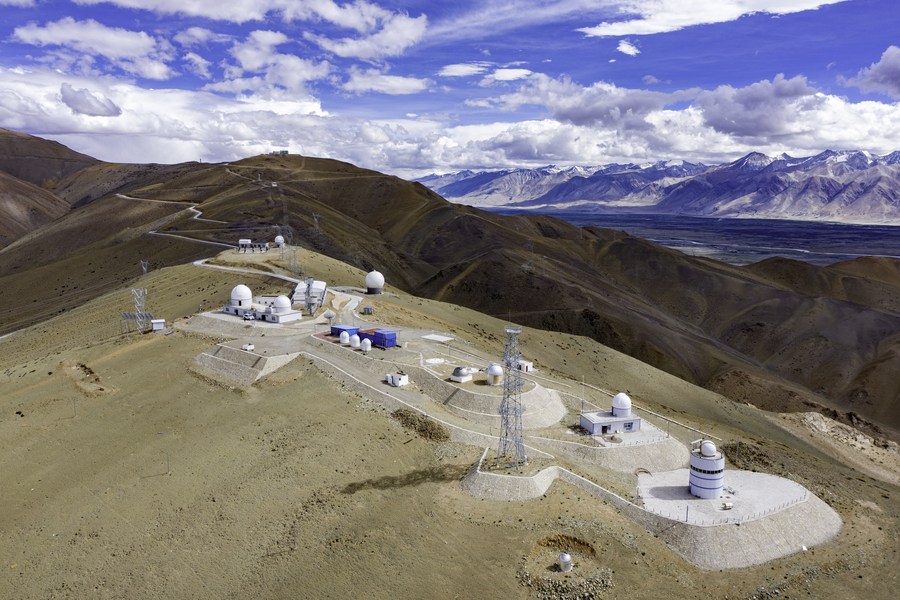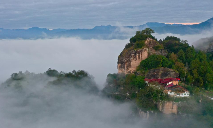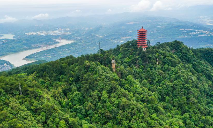A decade of stargazing on roof of world
* The Ngari Observatory in Tibet has marked its 10th year on the "roof of the world," carrying on Chinese people's never-ending exploration of the sky.
* Thanks to Ngari's thin and clean atmosphere with much less smoke, dust and water vapor, and low precipitation, the observatory is the highest and best astronomical observation point in the Northern Hemisphere.
* With the country's first dark night park featuring stargazing, Ngari has become a hot destination for tourists interested in star observation and photography.

Aerial photo taken on July 20, 2021 shows the Ngari Observatory of National Astronomical Observatories (NAO) in Ngari Prefecture, southwest China's Tibet Autonomous Region. (NAO Ngari Observatory/Handout via Xinhua)
LHASA, June 10 (Xinhua) -- When stargazing from the Ngari Observatory on a dark night, it is only natural to recall the wise words from German philosopher Immanuel Kant: "Two things fill the mind with ever-increasing wonder and awe...the starry heavens above me and the moral law within me."
The observatory, standing 5,100 meters above the sea level in southwest China's Tibet Autonomous Region, has marked its 10th year on the "roof of the world," carrying on Chinese people's never-ending exploration of the sky.
Twenty years ago, the National Astronomical Observatories (NAO) launched a major scientific research program to select an astronomical site in western China. Ten years ago, they cast their eyes on Ngari Prefecture in western Tibet.
Thanks to its thin and clean atmosphere with much less smoke, dust and water vapor, and low precipitation, Ngari is the ideal place for astronomers to gaze at the stars and the distant universe.
"Despite its high altitude and harsh natural environment, Ngari has the richest conditions for space and astronomical observation because it is so close to the stars," said Yao Yongqiang, a researcher with the NAO.

File photo taken on April 23, 2017 shows the Ngari Observatory of National Astronomical Observatories (NAO) in Ngari Prefecture, southwest China's Tibet Autonomous Region. (NAO Ngari Observatory/Handout via Xinhua)
In 2012, senior experts from China, Japan, the Republic of Korea and France agreed that initial observatory results of the Ngari Observatory promised it to become one of the best infrared and submillimeter observation sites in the world. Upon completion, it is now the observatory with the highest altitude and best astronomical observation point in the Northern Hemisphere.
A series of international cooperation and state projects, including quantum teleportation experiments, a primordial gravitational wave detection program, space debris and time-domain astronomical observations, have been launched at the site, yielding remarkable scientific achievements, according to Chen Ding, the chief scientist at the observatory.

File photo taken on May 2, 2017 shows quantum teleportation experiments in Ngari Prefecture, southwest China's Tibet Autonomous Region. (NAO Ngari Observatory/Handout via Xinhua)
A team of Chinese scientists is building the world's highest primordial gravitational wave observatory, aiming to make the first precise measurements of primordial gravitational waves in the Northern Hemisphere and capture the "first cry" of the universe's birth.
The Ngari Observatory is also an important node of the Las Cumbres Observatory Global Telescope Network (LCOGT), currently the most important global observation network for astronomical research, in its Northern Hemisphere observation network.

Scientists work at the Ngari Observatory of National Astronomical Observatories (NAO) in Ngari Prefecture, southwest China's Tibet Autonomous Region, Dec. 19, 2016. (NAO Ngari Observatory/Handout via Xinhua)
STARGAZING TOURISM
In November 2018, an astronomical science popularization base was unveiled at the Ngari Observatory.
The base is designed to be a unique center for astronomical science popularization and education by taking advantage of the Ngari Observatory's fine conditions for observation and its research and innovative capacity.
With the country's first dark night park featuring stargazing, Ngari has become a hot destination for tourists interested in star observation and photography.
"The moon photos I took using my smartphone are as good as NASA's," quipped Yang Feng, a local official who is himself a shutterbug. "From here, you can not only look at the stars but also see the satellites that pass over. Even the reflectors and antennas of the satellites can be seen clearly."
The park has six refracting and reflecting telescopes, and provides a special platform for shutterbugs.

Composite photo taken on April 7, 2022 shows Ngari Observatory of National Astronomical Observatories (NAO) in Ngari Prefecture, southwest China's Tibet Autonomous Region. (Xinhua/Jiang Fan)
An online platform for astronomical science popularization was also built, allowing astronomy lovers from around the world to observe the night skies in Tibet in real-time through a remote control telescope.
On June 21, 2020, some 200 million people observed a grandiose natural phenomenon -- an annular solar eclipse -- on livestreaming platforms through cooperation with the Ngari Observatory. "Eclipses on the plateau really look more spectacular," read an online comment.
With an increasing number of tourists, the night park has become a highlight of Ngari's plateau tourism.
"As the night closes in, the place becomes a mysterious dark world, and the stars are the only protagonists," said a tourist. "The starry sky has been shining for thousands of years. There is nothing in my mind now but the stars and the universe."
(Reporting by Shen Hongbing, Zhai Yongguan, Chen Shangcai, Tian Jinwen, Fan Fan and Cao Bin)
Photos
Related Stories
- Barren land by Yarlung Zangbo River sees sea of green trees in SW China's Tibet
- Stunning view of Yamzho Yumco lake - one of the three sacred lakes in Tibet
- Tibet still among world's best regions in environment: report
- Caterpillar fungus harvested in China's Tibet
- Feature: Rural projectionist heralds cinematic joy for Tibetan villagers
Copyright © 2022 People's Daily Online. All Rights Reserved.









